![Portrait of Lukas Foss, [n.d.].](https://webarchive.library.unt.edu/eot2008/20090113232350im_/http://www.loc.gov/exhibits/macdowell/images/mid20_feature.jpg)
|| Mid-20th Century AT THE MACDOWELL COLONY || About this image
About this image
By its fiftieth anniversary in 1957, The MacDowell Colony was operating year round in order to accommodate as many artists as possible. They represented the diverse artistic movements of the day, and many felt they did some of the best work of their careers at MacDowell.
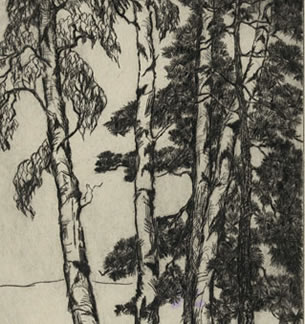
Birches and Pines, MacDowell Colony Woodland. 1937.
Elizabeth White. Etching and drypoint.
Prints and Photographs Division (28)
(at MacDowell 1933-34; 1936)
Digital ID# ppmsca-13433
© Sumter County Gallery of Art, Sumter, South Carolina
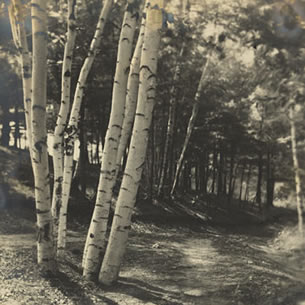
Birches at the Sprague Smith Studio, 1925.
Jessie Tarbox Beals. Copyprint.
Prints and Photographs Division,
Library of Congress (29)
Digital ID# ppmsca-13470-0014
MacDowell Birches
South Carolina artist Elizabeth White (1893–1976) studied art in Philadelphia before coming to The MacDowell Colony in 1933–1934 and again in 1936. Like so many artists at the Colony, White found inspiration in the beauty of her surroundings there. The stand of birch trees outside the Sprague Smith Studio is from a series of photographs taken of the Colony in 1925 by pioneering photographer Jessie Tarbox Beals (1871–1942) and may have inspired White’s Birches and Pines, MacDowell Colony Woodland.
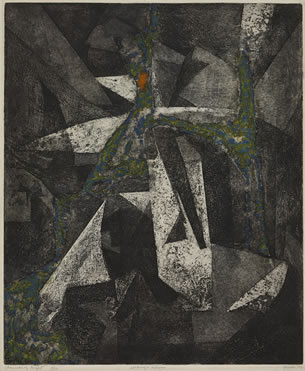
Jan Gelb. Channels of Night, 1957.
Color etching and relief.
Prints and Photographs Division,
Library of Congress (43)
Digital ID# ppmsca-13437
Courtesy of Julie Heller Gallery
Abstract Expression
New York educator, painter, printmaker Jan Gelb (1906–1978) worked at the MacDowell Colony from 1955–1957, and again in 1972. Early in her career, she studied art at the Yale University School of the Fine Arts in Boston and the Art Students League in New York City. Shortly after she made this print, her work was featured in 1958 in the Whitney Museum of Art exhibition Nature in Abstraction. Here, she combines geometric and organic abstraction; weaving a limited color palette into an overall structure of fractured black and white shapes.
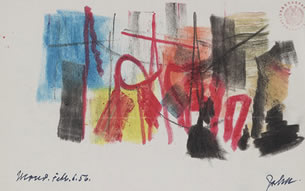
John Von Wicht to Marian MacDowell, February 6, 1956.
Holograph letter.
Edward and Marian MacDowell Collection,
Music Division, Library of Congress (45)
Digital ID# mc0045
Courtesy of the MacDowell Colony
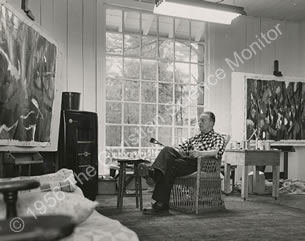
Artist John Von Wicht at The MacDowell Colony, January 1956.
Gelatin silver print.
Prints and Photographs Division,
Library of Congress (46)
Digital ID# ppmsca-13439
Gordon N. Converse © 1956 The Christian Science Monitor (www.csmonitor.com). All rights reserved.
An Expressionist's Thanks
Abstract expressionist painter John Von Wicht (1888–1970) attributed the critical acclaim that came to him at the end of his career to his time spent at The MacDowell Colony between 1954 and 1965. "All the work I did at the colony is so much better than any work done before," he wrote to Mrs. MacDowell in 1956. "All work shown at my last exhibit was done here. The paintings had a certain unity, sureness and were filled with a mysterious light never achieved before."
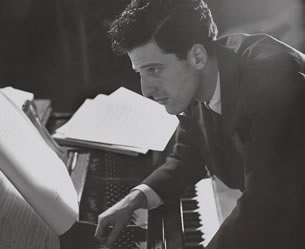
Portrait of Lukas Foss, [n.d.].
Victor Kraft.
Aaron Copland Collection,
Music Division, Library of Congress (38)
Digital ID# mc0038
Lukas Foss
Lukas Foss was only twenty-two when his cantata The Prairie won the New York Music Critics’ Circle Award in 1944. Foss worked on The Prairie at The MacDowell Colony at the start of a productive series of residencies that ran from 1943 to 1950. He was a protégé of Serge Koussevitzky, the eminent conductor of the Boston Symphony Orchestra and advocate of contemporary American music, who programmed the works of many Colony Fellows, including Roy Harris, David Diamond, and Gardner Read.
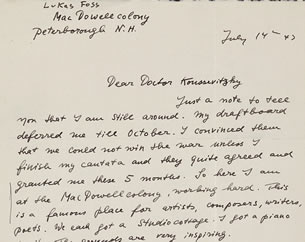
Lukas Foss to Serge Koussevitzky, July 14, 1947. Holograph letter.
Serge Koussevitzky Archive,
Music Division, Library of Congress (39)
Digital ID# mc0039
A Visit from the Maestro
"My draft board deferred me till October," Lukas Foss wrote to Serge Koussevitzky in 1947. "I convinced them that we could not win the war unless I finish my cantata and they quite agreed. So here I am at the MacDowell Colony, working hard." Koussevitzky had been hearing about the Colony for some time. When he finally visited Peterborough in 1948, he noted a spiritual affinity between its intense creative atmosphere and the eager, talented youth of Tanglewood, his music center in the Berkshires.
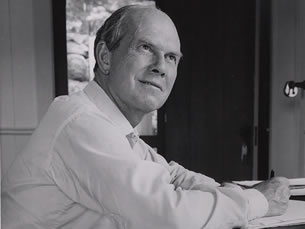
Portrait of Alec Waugh at The MacDowell Colony, ca. 1958.
Manuscript Division, Library of Congress (48)
Digital ID# mc0048
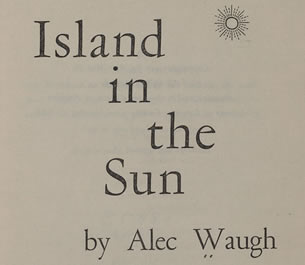
Island in the Sun.
Alec Waugh.
New York: Farrar, Straus and Cudahy, 1955.
General Collections, Library of Congress (49)
Digital ID# mc0049
Island in the Sun
During his first residency at The MacDowell Colony in 1951, novelist Alec Waugh told Marian MacDowell that he had been looking all his life for such working conditions. His novel Island in the Sun was largely written at the Colony and named a Literary Guild selection in 1956. “This is a big thing for me,” he wrote to Mrs. MacDowell on hearing the news, “and I am deeply conscious of how much I owe the colony.”
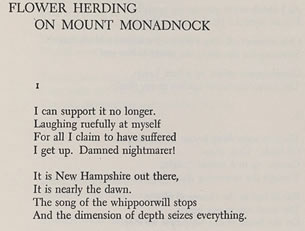
Flower Herding on MountMonadnock.
Galway Kinnell. Boston: Houghton Mifflin, 1964.
First edition.
Rare Book and Special Collections Division,
Library of Congress (52)
Digital ID# mc0052
Courtesy of Houghton Mifflin
Flower Herding on Mount Monadnock
Poet Galway Kinnell’s (b. 1927) second book, Flower Herding on Mount Monadnock, was acclaimed for its subtlety, depth, and simplicity when it was published in 1964. The title poem recounts a man’s solitary climb up Mount Monadnock at dawn and depicts the often obscure relationship between man and nature. It is included in Kinnell’s A New Selected Poems, published in 2000. Galway Kinnell worked at The MacDowell Colony eight seasons between 1959 and 1992.
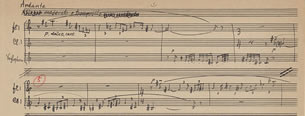
Notturno, 1953.
Ernst Toch. Autograph score.
Music Division, Library of Congress (54)
Digital ID# mc0054
By permission of the Estate of Ernst Toch
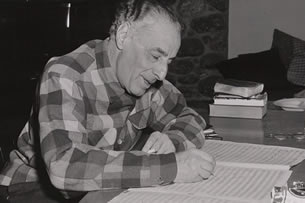
Portrait of Ernst Toch, ca. 1957.
Photograph.
Bernice Perry, photographer
Manuscript Division, Library of Congress (55)
Digital ID# mc0055
Courtesy of the MacDowell Colony
Night Music
Ernst Toch (1887–1964) was a rising star in the Neue Musik movement in Europe when World War II forced him to flee Germany. He was among many composer exiles to settle in the United States. The MacDowell Colony was a favorite workplace. He held five residencies from 1953 to 1957, one of the most prolific periods of his career. An evening walk in the woods at the Colony in 1953 inspired Toch’s Notturno, op. 77.
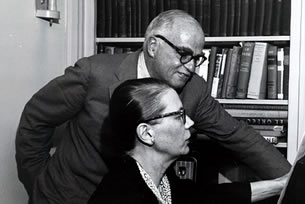
Thornton Wilder and Louise Talma examine their opera, The Alcestiad, ca. 1958.
Photograph.
Bernice Perry, photographer
Records of The MacDowell Colony,
Manuscript Division, Library of Congress (56)
Digital ID# mc0056
Courtesy of the MacDowell Colony
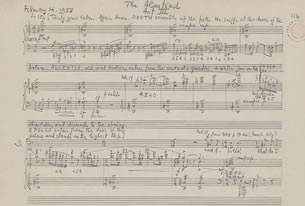
The Alcestiad, Act III.
Louise Talma. Autograph score.
Louise Talma Collection,
Music Division, Library of Congress (57)
Digital ID# mc0057
An Artistic Collaboration
Louise Talma worked at The MacDowell Colony for forty-three seasons between 1943 and 1995. The first year she came she met Lukas Foss, and each subsequent year she made friends and professional colleagues who made her career as a composer possible. Her friendship with Thornton Wilder began in 1952, and in the best sense of interdisciplinary exchange, the composer and writer agreed to work together on an opera, The Alcestiad.
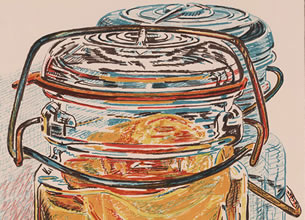
Preserved Peaches, 1975.
Janet Fish. Color lithograph.
Prints and Photographs Division,
Library of Congress (65)
Digital ID# ppmsca-10485
Courtesy of Janet Fish
Magical Realism
Boston-born artist Janet Fish (b. 1938) attended The MacDowell Colony in 1969–1970 and again in 1972. In the 1960s, Fish turned her earlier abstract style toward increasingly representational imagery. This image is part of a series featuring vegetables and fruits. Colorful and lushly textured, she isolates her subjects on the page and explodes the scale, encouraging the viewer to take a closer look.






